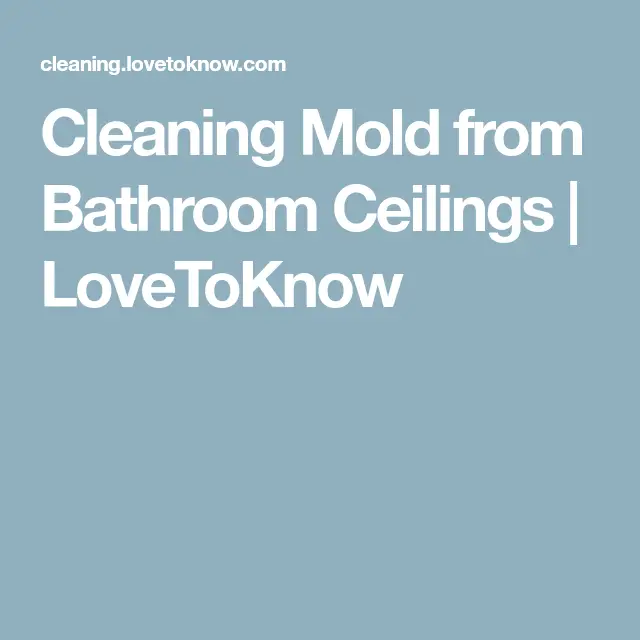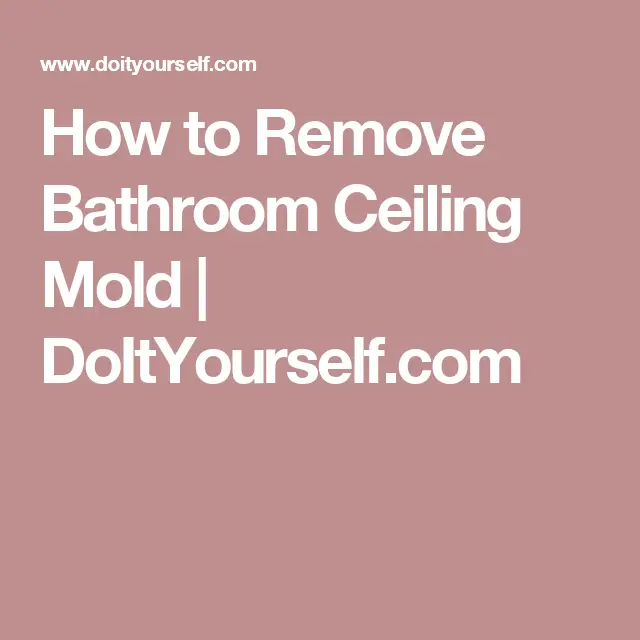How To Stop Mould In Your Bathroom
If you cannot cure the problem by reducing the levels of condensation either by ventilating or using the heating, there is another solution.
This is to kill the mould and treat your walls to prevent its future growth, despite the high levels of condensation.
There are 3 relatively simple steps:
For a relatively small cost and effort it is possible to stop mould growing on your ceilings.
Black Mould On Bathroom Ceilings
Understanding what mould is will help in understanding how to get rid of it.
Mould is a type of fungus and features threads, like very dense cobwebs that grow together on a given surface and some of them are fertile enough to produce spores.
Spores are carried by moving things including air and especially warm air, which is always found in a bathroom.
The warm air travels upwards depositing spores on the ceiling. The spores then settle and grow to become mould.
The conditions mould likes best are when temperatures are above 70 degrees Fahrenheit and the relative humidity is above 70% and have a guess where those conditions are found ?!
This is important because other than the unsightly stains that the mould causes the spores can also cause respiratory problems.
This is why you should never try and scrape away the mould this will release the spores into the air in the form of a fine dust which can cause breathing difficulties especially if you are prone to respiratory problems.
Black mould that is found in habitable rooms, especially bedrooms, is a much more serious condition, due to the prolonged exposure to the spores that the occupants will receive.
The treatment is the same, but much more urgent. Thankfully issues such as these are much less common
The other thing to understand is that this is a fungus and like many other fungi, black mould will cause a nasty odour this is a distinctive musky smell.
How To Prevent Future Mold Growth
Molds exist in all environments, but it requires constant moisture to reproduce and grow. Thats why a bathroom is such an ideal environment for spores to flourish. When theres moisture, whether its in the sink, the bathtub, or the shower, there are ways to prevent this from developing into a full-blown mold problem.
The key to mold prevention is to keep the moisture level down with proper ventilation. Be sure that an exhaust fan is installed and functioning properly to circulate the air in the entire bathroom. Ensure there are no water leaks from the faucets or valves and that the drains arent clogged.
Water dripping constantly or gathering in one area of your bathroom is a great way to promote mold growth and ensure that your entire bathroom remains damp. If any leaks in the pipes or walls need repair, do so expeditiously.
Recommended Reading: How To Remove Mold From Headliner
Removing Black Mould On Bathroom Ceilings And Walls
What are the causes of black mould? This project explains removing black mould on bathroom ceilings and walls and the conditions that cause it to grow and what can be done to try and stop, in most cases, the condensation that causes it. Also find out about methods of black mould treatment and removal and also what you can do to prevent it from appearing again.
The growth of black mould on bathroom ceilings and walls is a sign of condensation, and in bathrooms there is generally plenty of that!
The warm air laden with moisture comes into contact with a cold surface and that cools the air so that it can no longer hold the moisture which then condenses on that surface.
This is why condensation is typically found on windows and other colder areas. Find out more specific advice on condensation and how to prevent it here.
If there is enough condensation and especially if the environment is slightly warm such as on a bathroom ceiling or wall then black mould can grow.
Black mould on ceiling and walls Image courtesy of blackmold.awardspace.com
Sliced Orange And Vinegar

Orange isnt just great for supplying our body with the much-needed vitamin C. It is also great for cleaning and getting rid of unsightly molds in the house. There are two ways in which you can use sliced orange and vinegar to clean mold.
One way is to create a cleaning liquid by soaking orange peels in vinegar and then spraying the mixture on the moldy area. Leave this for a few minutes and wipe off with a damp cloth.
You can also try slicing an orange in two. Then use the face of the cut orange to scrub the moldy area. Leave the area for about five minutes so the acid in the orange can work on the molds. When this is done, use a spray bottle to apply vinegar on the mold and then wipe immediately with a dry cloth.
Also Check: Uv Lights To Remove Mold
Don’t Miss: What Happens During Mold Remediation
Mix A Cleaning Solution
In a plastic bucket, mix one-part dishwashing liquid, 10 parts bleach, and 20 parts water. To clean a small area of mold, mix a solution of one tablespoon dishwashing liquid, 1/2 cup chlorine bleach, and one cup of warm water in a spray bottle. The dishwashing liquid will help the solution cling to the ceiling longer to kill the mold.
How Do I Know If I Have Mold Vs Mildew
Mold and mildew differ in the way they grow and what they look like. The biggest difference between mold and mildew is how they grow. Mildew only grows on the surface. Mold grows inside of its food source. Mold has to be removed completely not just cleaned.
Mildew is always flat, and may begin white and then turn brown, gray or black. Mold is usually fuzzy and raised, comes in many colors, and always grows inside its food source. Mold can be many different colors ranging from white, yellow, green, gray, to black. In the photo above, mold is growing in the drywall surrounding the bathtub. All the drywall will have to be removed not just cleaned. This job is too big for a homeowner and should be performed by a professional.
Recommended Reading: How To Clean Surface Mold Off Wood
Put On Protective Gear
When removing mold, it is best to wear old clothes that you won’t mind being splattered with bleach and that can be washed in hot water to remove any mold spores that might scatter. Put on a face mask, protective eyewear, and gloves.
To improve ventilation in the bathroom while you are cleaning, open windows or add a circulating fan. Turn on the bathroom ventilation fan, as well.
Clean Mold From Your Bathroom Ceiling
You can use any of the recommended cleaning solutions in this article. Begin by spraying the affected site generously with either a borax or vinegar solution. If you choose to use vinegar solution and your ceiling is coated with paint, spray directly on the moldy site and wipe it with a clean rag or sponge mop.
If it does not work, you will need to scrape off and change the damaged ceiling area. Seek help from mold removal experts when taking off a severe moldy textured ceiling. Because this area requires protective clothing and particular ventilation masks.
Recommended Reading: How To Remove Mold From Jet Ski Seat
How To Clean Mold Off Coins
Vinegar. A common ingredient in DIY eco-friendly cleaners, the acetic acid in white vinegar can help wear away the contamination on your coins. Soak your coins in a glass or other non-corrosive container for at least 30 minutes, up to overnight, and then wipe with a clean cloth or scrub gently with an old toothbrush.
How To Prevent Mildew In A Shower Ceiling
Related Articles
Shower ceilings can provide ideal conditions for mildew and mold to grow. Mildew likes dampness, darkness and warm temperatures, all of which take place in the average shower on a daily basis. If left untreated, mildew can spread across the ceiling, gradually damaging it more and more, and affect your health. To prevent mildew from growing, remove the conditions that favor it, and make sure the rest of the shower area is free of growths, as well.
Tip
If your shower ceiling already has a mildew problem, spray it with the hydrogen peroxide solution a second time a few hours after the first time, and spray it a third time the following morning.
Wear a respirator while removing mold and mildew.
You May Like: How To Get Tested For Mold Exposure
Will Vinegar Kill Mold On The Ceiling
Vinegar is surprisingly effective on mold thanks to its acidic chemical makeup. As the product of fermented ethanol and acetic acid bacteria, it has a natural pH of roughly 2.5. This level of pH is very mild but strong enough to kill mold spores without driving them further into the porous surfaces theyre growing on. Not only does vinegar have anti fungal properties, its also been shown to be a great antibacterial cleaner as well, so using it can leave your household surfaces sanitized in the end.
The type of vinegar you choose to get rid of mold is extremely important distilled white vinegar is usually the most effective choice due to its lack of sugar or other ingredients. Alternatives like wine vinegar or apple cider vinegar might get the job done, but the sugar they contain is something mold spores can feed on, which increases the risk of the outbreak returning.
Heck Out Our Bedroom Ceiling After We Removed Drop Paneling That Was Used To Cover This Up Cant Tell If This Is Mold Cigarette Smoke Residue Or What Any Input On Whether This Could Be Black Mold

This is a bit tricky to determine without testing. I recommend grabbing a piece of the suspicious material and bringing it to a local lab. They should be able to determine if its mold growth. If not, your hunch regarding smoke residue is likely correct. Cigarette smoke typically causes yellow & brown staining. The black color of the staining in this photo points more toward mold growth or smoke from a fire.
You May Like: How To Get Rid Of Mold And Mildew In Basement
How To Remove Mold From A Tiled Bathroom Ceiling
If your bathroom ceiling is tiled, you will need to take a slightly different approach to remove mold.
How To Clean Mold Off Bathroom Ceiling
Once you have completed your shower mold removal, you might find a few patches on your ceiling, too. You will repeat the same steps described above to remove it, but you must be careful not to drip any cleaning agents on yourself in the process. Use a step ladder or long-handled brush to safely reach the ceiling. You must also dry the ceiling, once you are done cleaning it. Again, a step stool or long handle with a towel attached can help.
Also Check: Does Mold Cause Health Problems
What Can I Spray To Prevent Mold
Vinegar and baking soda liquid spray cleaners both provide a protective barrier against mold growth and recurrence. In addition to this, several other natural remedies, like tea tree oil and hydrogen peroxide, can also help prevent mold from growing back once youve cleaned it up.
There are countless mold-prevention sprays available at hardware stores near you that can be used right after the mold cleanup process. Nearly any mold preventative you find should have some kind of anti-fungal ingredient or water-dispelling component that helps keep at-risk surfaces clean, dry and mold-free.
Also Check: What Are The Effects Of Black Mold In Your House
In My Bathroom The Light Fixture Is Not Working So No Light Gets In At Any Time I Recently Noticed A Very Musty Smell Which Is Also Throughout The House I Would Like To Know If My Health Is At Stake Thank You For Your Patience In Reading This Message
The lack of light in the bathroom would not directly cause the mold growth. The main cause of mold on a bathroom ceiling is a broken or ineffective exhaust fan. I recommend replacing the fan with a constant flow unit such as the Panasonic WhisperGreen fan. Here is a link. If thats outside of your budget, you can install a timer switch on the existing fan. Run it at least 12 hours/day in the cooler months.
Also Check: What Are The Symptoms Of Mold In Your House
Choose The Right Vinegar
Plain white distilled vinegar does well against mold, and you likely already have it in your kitchen. This vinegar has about 5% acidity, which is plenty to kill the mold and any live spores. However, it must come in contact with the mold directly.
You can also use cleaning vinegar, which has about 6% acidity. While you may not have this one in your home, it is commercially available online and from most grocery stores. The slight increase in acidity makes it a bit more effective against the mold strains that do respond to vinegar.
Generally, other varieties of vinegar are not effective at removing mold. Using apple cider vinegar or infused vinegar does not help you kill molds since they have different compositions from plain distilled vinegar.
Is Bathroom Ceiling Mold Dangerous
Yes, it is. The longer you wait to initiate mold removal efforts, the more harmful the mold will be. If you neglect mold spores or black mold for an extended period, you will have problems later. Mold grows fast in damp areas. Once this happens, youve crossed the point of no return. Even if you remove the mold after its too late, it will leave behind dark spots.
Also Check: How Long After Water Damage Does Mold Grow
Mould Removal With Vinegar
Many choose vinegar over bleach or other chemicals because it is 100% natural and safe. It does not emit any dangerous fumes into your home like most chemicals do. Like bleach, it can also kill and prevent future mould growth, but only if applied regularly to areas prone to mould around your home. When cleaning with vinegar, gather these items and follow the steps:
- Scrubbing brush
- Plain water and clean cloths
Step One: Pour the vinegar into the dry spray bottle and spray a good amount on to the mould-infested areas. Allow it to sit for an hour before you move on to the next step.
Step Two: Using a clean cloth soaked in plain water, wipe away the mould from the walls and ceilings. You can also use a scrubbing brush with firm bristles as it is more effective in removing hardened fungus and stains.
Step Three: Use a dry, absorbent cloth to soak up moisture by dabbing or pressing against the cleaned areas. Keep the windows open to dry the area quicker and allow the vinegar smell to go out.
Step Four: To help prevent mould growth using vinegar, ceiling corners and other areas where mould is likely to grow should be sprayed once or twice a week using the same vinegar in the bottle.
Recommended Reading: What Kills Mold On Concrete
Dealing With Poor Ventilation And High Humidity

Since humidity is actually the main cause of mold, the first thing to be concerned about is ventilation. If you dont already have bathroom fans, now is the time to get and install them. Keep your fan on for up to 30 minutes after each shower. Opening the door and windows will do the same trick if, for any reason, you cannot afford this investment right away.
We have already mentioned that keeping the bathroom door closed while showering can increase the chances of mold growth in your bathroom. In case you still do not want to shower with the bathroom door open, or it is too cold to open a window, you should opt for a strong and effective exhaust fan that will compensate for this. Mechanical exhaust is crucial in controlling and expelling excess humidity caused by showers.
Of course, leaving the window open will not help you if you live in a humid climate. If this is the case, you will have to rely on dehumidifiers to prevent mold. They are often inexpensive and freestanding, which lowers the installation costs. It is very important to keep in mind that mold needs as little as 55% humidity to grow, so do make sure that your dehumidifier is set right or you may still have a problem.
Did you know?
Only 13% of bathrooms we have tested didnt have presence of mold?! Find out more exciting mold stats and facts inside our mold statistics page.
Read Also: How To Get Mold Out Of My Car
Mold On Bathroom Ceiling What To Do And When To Call
Why is mold growing on your bathroom ceiling? How do you get rid of it? Bathroom ceiling mold removal can be a DIY project, but its a good idea to know when to call the professionals. How do you know when to clean and when to call? Come read and learn everything you need to know about bathroom ceiling mold.